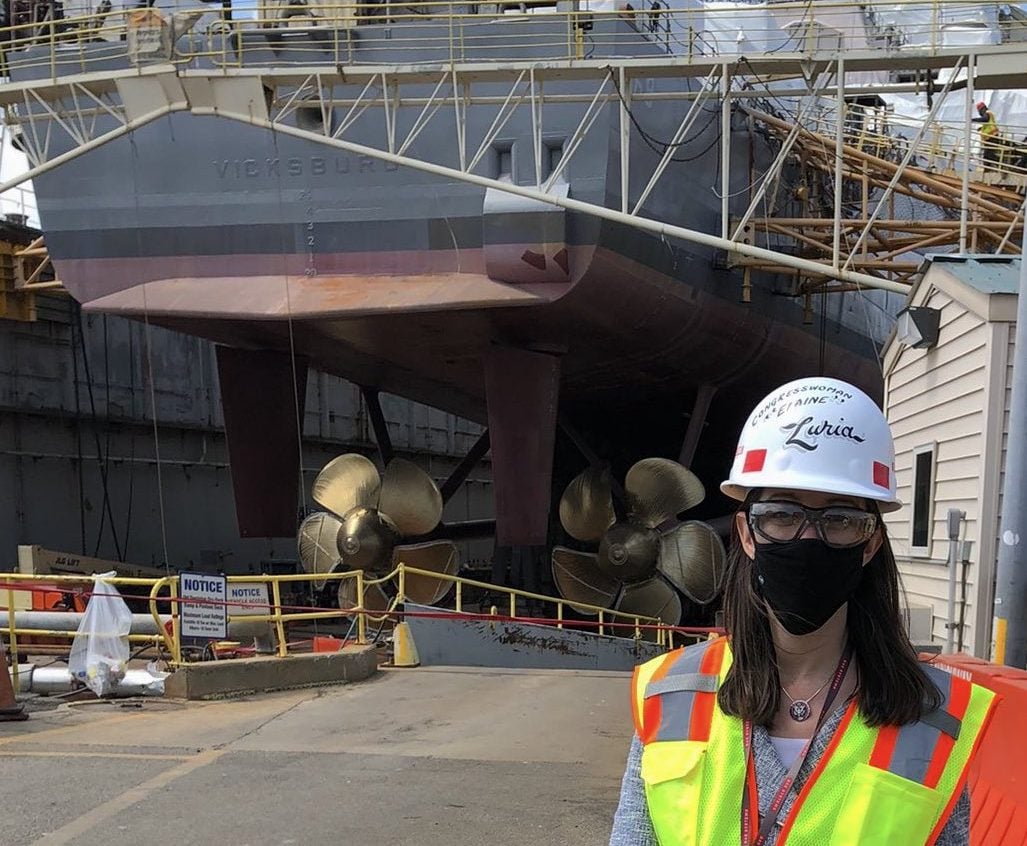
To counter threats from China, a top U.S. lawmaker Friday called on the U.S. Navy to develop a new maritime strategy that would rebalance how it deploys and strategically scattered persistent deterrent force in an arc throughout the Indo-Pacific region.
Two decades of focus on the Middle East has strained U.S. naval forces and worn out its fleet of carriers, said U.S. Rep Elaine Luria (D-Va.), a retired Navy surface warfare officer and vice chair of the House Armed Services Committee.
Luria used the recent example of the aircraft carrier USS Ronald Reagan (CVN-76), which is forward deployed to Japan, being sent to the Middle East to support the U.S. withdrawal of forces from Afghanistan.
“What we’re seeing today is not a persistent deterrent, because if our deterrent in the Pacific is the carrier strike group and its other ships, but they leave to go to a different area of the world in order to respond to a different crisis, then that leaves a gap for a period of time,” Luria said. Her comments came during an online Center for Strategic and International Studies panel focused on the South China Sea.
Luria’s proposed strategy was published by the Center for International Maritime Security earlier this month. It also outlines approaches for a maneuver force, as well as deterrent forces to respond to emerging threats in the Arctic.
Presence in the South China Sea has become increasingly urgent for the U.S. and its allies. China has fortified artificial reefs in the Spratly Islands, which are also claimed by Vietnam and the Philippines. It has also increased its aggressive tactics against Taiwan, which it has promised to reunite with its mainland. In recent months, the Philippine Coast Guard accused China of deploying a fleet of Maritime Militia vessels to the Whitsun Reef in a show of aggression as well.
Maintaining a persistent presence in the South China Sea and increasing interoperability with allies would not only show a unified force to confront the Chinese, but also develop the sort of familiarity with merchant and fishing vessels necessary to prevent “gray-zone” miscalculations, she said.

“It’s very important to understand those patterns, because if you don’t understand the patterns and the frequency by which they happen and how those interactions will happen with other vessels in the area—not necessarily military vessels—then you don’t understand when it changes,” Luria said.
Friday’s panel came amid news that Philippine President Rodriqo Duterte restored the Visiting Forces Agreement between that country and the U.S. following a visit to Manila by Defense Secretary Lloyd Austin, III., who is traveling the region this week to bolster U.S. alliances. Duterte had previously backed out of the pact, which allows combat exercises with the Philippines and the U.S., as he sought to rebuild ties with China, USNI News reported.
Austin said in a press conference Friday during his visit to Manila that the VFA provides “certainty for us going forward, where we can do long-range planning, and do different types of exercises and incorporate more capability.”
“It’s a very welcome decision, and we look forward to continuing to partner with our great partners here in the Philippines,” Austin said.
Luria referred to the Whitsun Reef incident as an example of China’s continuous efforts “to test the United States, test our allies … and how we will support each other.” She called Friday’s announcement “a strong testament to the fact that the other countries which are being threatened by these actions from China actually want to stand with the U.S. and our allies collectively.”
Luria continued her criticism Friday of the Biden administration’s proposed defense budget, saying that it fails to adequately counter China, even as top U.S. military officials continue to call the country a No. 1 threat and priority. Chief of Naval Operations Adm. Mike Gilday has argued for divesting more than a dozen vessels to invest in newer technologies at a time when budgets remain austere.
“I don’t feel that there is a direct correlation between saying China is our number one priority, and the priorities we’ve actually made in the proposed budget and that we’re working through this year,” she said. “So, I feel that there’s a say-do gap between the two of those things.”
The seven guided-missile cruisers that fall into the divestment proposal represent a third of the Navy’s cruiser fleet, Luria said. While those cruisers are reaching the end of their service life and need upgrades, Luria said few of the Navy’s ships that have been decommissioned in the last decade would be able to be brought back to the fleet rapidly if needed. Two decades of focus on a ground war in the Middle East has come at a cost to shipbuilding and developing weapons systems while China has built out capacities that will require the U.S. to modify and adapt its tactics.
The U.S. Navy’s fleet totals about 297 vessels while the Chinese has grown to about 360 with plans to grow to 425 by the end of the decade, Luria added.
“I think there’s a lot of work to do, both Navy and Air Force, as far as having the right platforms, the right number of these platforms to deal with the growing size of the Chinese fleet,” Luria said.





